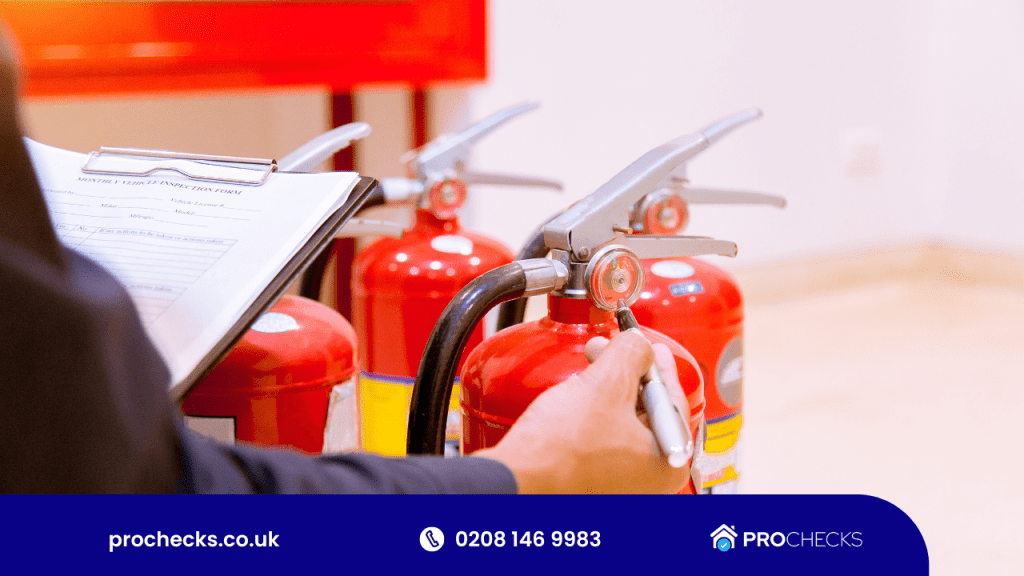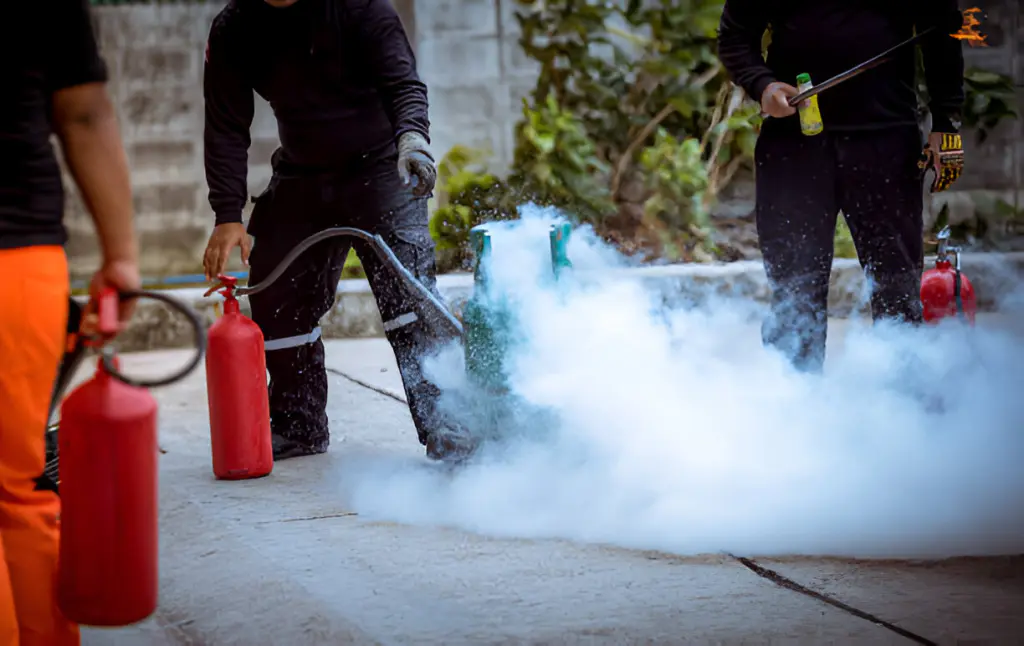When you’re working in confined spaces, choosing the right fire extinguisher isn’t just about quelling flames; it’s about your safety and that of your team. You should know that not all extinguishers are suitable for such environments. CO2 extinguishers, for instance, can dramatically reduce oxygen levels, creating a new hazard altogether. Let’s explore why certain extinguishers could do more harm than good and discuss what options you have that ensure both effective fire suppression and safe air quality. What might seem like a straightforward choice could have critical implications. What should you look out for? Let’s understand Discover Identifying Fire Extinguishers Unsuitable for Confined Spaces.
Types of Fire Extinguishers
Several types of fire extinguishers are available, each designed for specific classes of fires. As you navigate the selection process, it’s crucial to understand that the effectiveness of portable extinguishers depends largely on their alignment with fire classifications.
Class A extinguishers are suitable for ordinary combustibles like wood and paper, while Class B units are designed to tackle flammable liquids. Class C extinguishers are used for electrical fires, where non-conductivity is vital.

Class D extinguishers address fires involving combustible metals, and Class K units are specifically for kitchen fires involving cooking oils and fats. Each type utilizes a different extinguishing agent tailored to suppress the fire class effectively without worsening the situation.
When selecting a portable extinguisher, consider the fire risks prevalent in your environment. For confined spaces, size and weight are additional factors, as these areas require extinguishers that are both effective and manageable.
The rating system (e.g., 2A:10B:C) on extinguishers provides a guide to their capacity and suitability for different fire sizes in various settings.
Mastering the use of these extinguishers involves not only selecting the right type but also regular maintenance and understanding operational techniques to ensure readiness in emergencies.
Hazards in Confined Spaces
Confined spaces present unique hazards that demand your careful consideration when preparing for fire safety. These environments often restrict movement and can complicate escape routes in emergencies. You must assess the risks of oxygen deficiency, toxic atmospheres, and flammable gases.
Ventilation strategies are critical here; they ensure an adequate supply of fresh air and help in diluting or removing hazardous substances. Effective ventilation must be both sufficient in volume and correctly directed to be truly beneficial.
Your approach should also include rigorous confined space training. This training equips you with the knowledge to assess risks accurately, utilize appropriate safety equipment, and understand the complexities of fire behavior in restricted environments.
It’s not merely about knowing what to do but also understanding why certain actions are necessary and how they impact overall safety.
Unsuitable Extinguishing Agents
Many extinguishing agents on the market aren’t suitable for use in confined spaces due to their specific characteristics and potential hazards. For instance, water extinguishers, commonly utilized for Class A fires involving ordinary combustibles, can be problematic in confined areas. They create a significant risk of electrical hazard if used near live electrical equipment, which is often present in such environments.
Moreover, the use of water can lead to unnecessary water damage or the promotion of mold growth in poorly ventilated areas, complicating post-fire recovery.
Similarly, foam extinguishers, effective against Class A and B fires, pose specific challenges in confined spaces. The foam can obscure visibility, which is already limited in tight areas, increasing the risk of injury or disorientation during evacuation.
Additionally, the residue left by foam can be slippery and may require extensive cleanup, a significant drawback in enclosed environments where thorough ventilation and access may be restricted.
You must carefully assess the nature of the potential fire hazards and the characteristics of the extinguishing agents when selecting fire safety equipment for confined spaces. Opting for extinguishers that match the specific risks without adding additional hazards is crucial for safety and efficiency.
Oxygen Displacement Risks
In addition to the hazards posed by certain extinguishing agents, you must also consider the risks associated with oxygen displacement in confined spaces. When tackling a fire, the chemistry involved is complex, and the choice of extinguisher can critically impact the available oxygen levels. This is particularly crucial in confined environments where ventilation is limited, and the potential for oxygen displacement can lead to asphyxiation hazards.

Extinguishers that release inert gases or create a chemical reaction that absorbs oxygen dramatically alter the atmospheric composition. For instance, CO2 extinguishers, while effective in quenching flames by displacing oxygen, simultaneously reduce the breathable air. This poses a significant risk in confined spaces where the displaced oxygen mightn’t be readily replenished.
You must evaluate the fire suppression system‘s impact on environmental oxygen. Understanding the balance between extinguishing efficiency and breathable air retention is essential.
Opt for extinguishers that maintain a safer oxygen level while effectively controlling fire spread. Analyzing the specific fire chemistry and the dynamics of oxygen levels will guide you in selecting the appropriate extinguisher, ensuring both fire safety and human survivability in confined settings.
Chemical Residue Concerns
While considering the oxygen displacement risks of fire extinguishers in confined spaces, it’s equally important to evaluate the potential hazards posed by chemical residues.
You must be aware that certain types of extinguishers, particularly those using dry chemical agents like monoammonium phosphate or sodium bicarbonate, leave behind a powdery residue. This residue can trigger chemical reactions with exposed materials or equipment, potentially causing corrosion or other damage.
You’re tasked with ensuring that residue management protocols are in place to mitigate these risks. This involves choosing fire extinguishers that complement the specific environmental conditions of the confined space.
For instance, carbon dioxide or clean agent extinguishers, which leave no residue, might be preferable in spaces housing sensitive electronic equipment or high-value machinery.
Furthermore, understanding the chemical properties of the extinguishing agents and their interaction with the confined space environment is crucial. It’s not just about suppressing the fire; it’s about doing so without introducing new hazards.
Regular training and drills in proper application techniques will also reduce the likelihood of residue-related complications.
Impact on Evacuation
Selecting the appropriate fire extinguisher impacts how quickly and safely individuals can evacuate a confined space during an emergency. The choice affects not only the ability to control the fire but also the risk of exposure to harmful agents that can impede evacuation procedures. Understanding the dynamics of fire extinguishers and their applications is vital to optimizing emergency training and ensuring a swift, safe exit.
Let’s consider the characteristics of common extinguishers:
| Extinguisher Type | Effectiveness | Evacuation Impact |
|---|---|---|
| Water | Low on grease fires | High risk of slip, slow evacuation |
| CO2 | Good on electrical fires | Limited visibility, respiratory concerns |
| Foam | Moderate on various fires | Slippery residue, delayed evacuation |
Each type has its implications for evacuation. For instance, using a CO2 extinguisher might obscure visibility due to gas discharge, complicating navigation towards exit points. Water extinguishers could create slippery surfaces, increasing the risk of falls. Foam, while effective on multiple fire types, leaves a residue that might require careful maneuvering, potentially slowing down the evacuation process.
In your emergency training, it’s crucial to incorporate scenario-based drills that simulate these conditions. Such preparation ensures that you’re not only equipped to use the extinguisher effectively but also to handle the evacuation challenges it may introduce.
Alternatives for Confined Areas
Given the limitations and potential hazards associated with traditional fire extinguishers in confined spaces, exploring alternative solutions becomes necessary.
You’ll find that foam extinguishers present a viable option due to their capacity to suppress flammable liquid fires without creating an oxygen-depleting atmosphere, which is crucial in areas with limited ventilation.
Foam extinguishers function by forming a barrier between the fuel and the air, effectively smothering the fire and preventing re-ignition, which is particularly advantageous in confined environments where traditional dry chemical extinguishers might pose a respiratory threat.
However, it’s essential to consider foam extinguishers’ usage specifics, such as their compatibility with the materials and fire classes expected in your confined space.
Beyond foam extinguishers, other portable extinguisher alternatives should be evaluated based on the space’s unique characteristics.
These include halotron or clean agent extinguishers, which discharge a gas that interrupts the chemical reaction of fire without leaving residue. This feature is critical for spaces containing sensitive electronics or machinery.
When selecting an extinguisher type, you must assess factors like efficacy, potential for collateral damage, and ease of post-fire cleanup.
Mastery of these elements ensures optimal fire response readiness in confined spaces, enhancing safety and operational continuity.
Safety Guidelines Overview
Every confined space requires stringent adherence to specific safety guidelines to ensure optimal fire safety and personnel protection. You must first establish a comprehensive understanding of the space’s characteristics and potential hazards. This understanding is crucial for selecting appropriate fire extinguishers and designing effective emergency response strategies.
Training protocols are central to ensuring that all personnel can identify and use the correct types of extinguishers. Your training should cover not only the basic operation of extinguishers but also the decision-making process regarding when and where to deploy them within confined spaces. This includes recognizing the limitations and advantages of different extinguishing agents under variable conditions that a confined space may present.
Regulatory compliance is another critical area. You’re required to adhere to local and national fire safety standards, which dictate specific practices and equipment for confined spaces.
This compliance isn’t merely about following laws; it’s about integrating these standards into daily operations to maintain a high safety margin at all times.
Case Studies and Examples
Several case studies illustrate the critical importance of choosing and using the right fire extinguishers in confined spaces.
For instance, an incident in a chemical storage facility highlighted a significant lapse in fire extinguisher effectiveness due to improper selection. Here, a water-based extinguisher was used in a space filled with flammable liquids, leading to a rapid escalation of the fire instead of its suppression. This case underscores the necessity of understanding the specific requirements of the fire class and the volume limitations of confined areas.
Another example involves a utility tunnel where the deployment of a CO2 extinguisher caused a different hazard—oxygen displacement. Although effectively extinguishing the fire, the reduced oxygen levels created a life-threatening situation for the workers inside. This incident brings to light the dual need to adhere to confined space regulations while ensuring fire safety.
You must assess both the type of fire likely to occur and the environmental conditions of the space. Selection based on these assessments will maximize safety and compliance.
Understanding these parameters ensures that you not only choose the most effective extinguisher but also mitigate additional risks posed by incorrect usage in confined settings.
Conclusion
In confined spaces, choosing the right fire extinguisher is critical. Avoid water, foam, and dry chemical types due to their potential to create additional hazards like electrical risks, slippery residues, and corrosion. CO2 extinguishers, while effective, dangerously reduce oxygen levels, posing serious asphyxiation risks. Opt for alternatives specifically designed for confined environments to ensure safety without compromising air quality or evacuation routes. Always adhere to stringent safety guidelines, prioritizing well-informed choices based on precise risk assessments.









